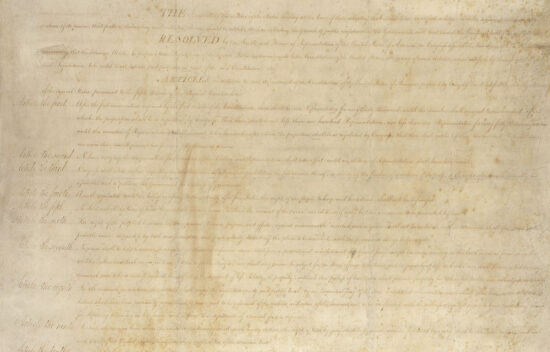
The Bill of Rights (ELL)
90 minHow does the Bill of Rights protect liberty?
Students will:
- Identify the rights protected in the Bill of Rights.
- Understand that government power must be limited to protect individual rights.
- Analyze and apply provisions of the Bill of Rights through guided scenarios.
- Evaluate Supreme Court rulings on cases centered on the Bill of Rights.
- Appreciate the importance of the Bill of Rights in safeguarding individual liberty.
Handouts may have two versions. Version 1 is at a higher level than Version 2.
- Handout A: The United States Bill of Rights
- Handout B: What Rights Are Protected by the Bill of Rights? (Versions 1 and 2)
- Handout C: You Be the Judge! (Versions 1 and 2)
- Handout D: Outcome Discussion Cards (Versions 1 and 2)
- Handout E: The Bill of Rights Today
- Handout F: Mock Supreme Court Procedures
- Handout G: The Bill of Rights Song
Have students discuss their answers to Handout B: What Rights are Protected by the Bill of Rights? (Version 1 or 2) in pairs.
- Divide students into eight groups and distribute Handout C: You Be the Judge! (Version 1 or 2).
- Assign one scenario to each group and instruct students to read and discuss their scenario. They should then discuss and answer the questions at the end. Allow groups about 10 minutes to complete this part of the activity.
- Once all groups have finished, reconvene the class and ask the members of the group that worked with Scenario 1 to read their situation to the class and report their answers.
- As a large group, locate the rights/amendments in the Bill of Rights involved with each scenario.
- Conduct a class vote to determine which side of the argument students agree with in the scenario. Record the results of the vote on the board.
- Continue until all scenarios have been presented.
- Distribute the cards on Handout D: Outcome Discussion Cards (Version 1 or 2) to students who are strong readers. Point out to students that the fictional scenarios they just discussed were all based on actual Supreme Court cases. Have them read the Supreme Court rulings for each scenario and allow class discussion on each.
- Make sure to emphasize to students that Supreme Court rulings are not substitutes for the Constitution’s text. The Court often overturns itself, and all citizens have the responsibility to evaluate their rulings in light of the Constitution.
- Ask students if they agree with the Court’s rulings. How would they use the Bill of Rights to support their opinions? Conduct a large group discussion to answer the questions:
- How does the Bill of Rights protect liberty?
- At their core, what do the protections in the Bill of Rights have in common?
- Why must government power be limited to protect individual rights?
- Distribute Handout E: The Bill of Rights Today. Have students research news stories that illustrate the individual rights and protections guaranteed by the Bill of Rights. Students could begin by searching the Teaching with Current Events pages on www.BillofRightsInstitute.org. Students should locate at least four examples and complete the graphic organizer to summarize the stories and draw connections to their lives.
- Have students discuss the Bill of Rights with their families and write a paragraph about the discussion.
- Using Handout F: Mock Supreme Court Procedures, have students hold a Mock Supreme Court hearing using either the Kelo v. New London (2005) property rights case or the Safford Unified School District # 1, et al. v. Redding (2008) search and seizure case. Information on the cases can be found at www.Law.Cornell.edu.
- Have students learn Handout G: Bill of Rights Song (to the tune of “The Twelve Days of Christmas”).





